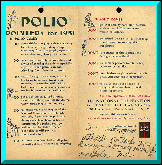









 |
page 1
| page 2 | page 3
In addition to research, the National Foundation funded practical
measures to ease the burden of the polio epidemics. When World War II depleted the
home front supply of doctors and nurses, the National Foundation funded scholarships and
training programs to re-staff hospitals. Sister Kenny's methods were more labour
intensive than splints, and the National Foundation paid to train Kenny therapists and to
place them on the polio wards. When hospitals needed more and more iron lungs and
rocking beds, the National Foundation organized regional supply depots, where the
equipment could wait out the lulls in preparation for speedy shipping to affected
areas. They also organized (and funded) squadrons of doctors and nurses who would
fly to epidemic areas to set up emergency hospitals. They printed pamphlets and
bulletins, and supplied them to doctors' offices and hospital waiting rooms, offering
advice ranging from how to pay ambulance bills to how to deal with the psychological
effects of polio on the siblings of paralyzed children.
"When in doubt, the final advice was always, 'Consult your
local chapter of the National Foundation for Infantile Paralysis. This service is
made possible by contributions to the March of Dimes.'" 1

Click above for a larger image of
this March of Dimes pamphlet.
The story of the Arkansas epidemic of 1949 is typical of the total
commitment to polio patients that the National Foundation displayed. Charles Massey
was regional coordinator for Arkansas, Kentucky, and Georgia in 1948. He tells his
story in A Paralyzing Fear.
He was contacted in the middle of the summer by the University Hospital,
the only hospital in Arkansas that would accept polio patients. They expected a
patient from the northern part of the state. It was a heads-up call; no one knew if
it was an isolated case or the first in a wave. That same day, several more calls
came in and within two days, the polio ward was full. The doctor in charge called
Massey and said, "I understand the March of Dimes is responsible for polio."
He explained that they needed equipment, nurses, doctors, iron lungs, etc.
Massey called the March of Dimes headquarters and then assured the doctor that all
would be taken care of.
The cases poured in. First they took over the nursing residence to
set up a respiratory center. A few years earlier, an epidemic in North Carolina had
overwhelmed the hospitals, and the March of Dimes had been forced to set up a field
hospital. They didn't want to do that again, so Massey had to call other hospitals
and convince them to take polio patients. Massey called the newspapers and invited
them to take pictures at University Hospital, where the patients were being lined up in
the hall. In a week, there was a polio ward in the chapel at Baptist Hospital.
St. Vincent's Hospital gave over an empty wing, and the National Foundation brought
in staff, beds, iron lungs, and rewired the wing and brought in refrigerators to
store pharmaceuticals.
The American Red Cross, the Joint Orthopedic Nursing Association, and the
American Physical Therapy Association had grants from the National Foundation to train
people in the care of polio patients. Nurses flew in from all over the country and
were housed in hotels. They even provided social workers to council the families of
polio patients, many of whom suffered tremendous guilt over their loved one's illness.
The way the National Foundation looked at it was that if you were the
hospital, you treated the patient and sent the bills to the March of Dimes.2
page 1 | page 2 | page 3


Footnotes
1. Seavey, Nina Gilden, Jane S. Smith, & Paul
Wagner. A Paralyzing Fear: The Triumph over Polio in America. New
York, New York: TV Books. 1998. pp. 77-78.
2. idem. pp. 85-88. |
